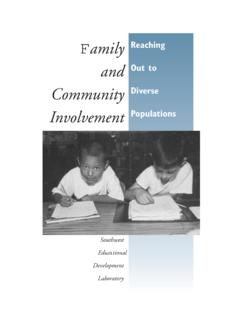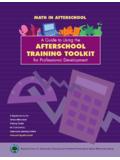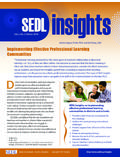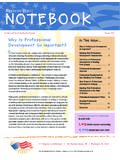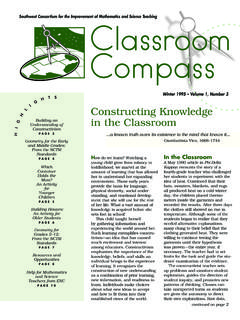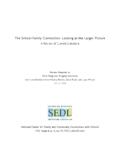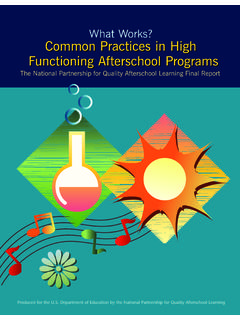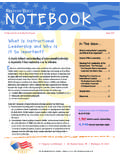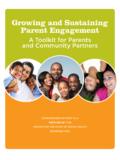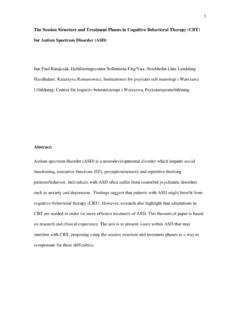Transcription of Synthesis of Research Studies - SEDL
1 Synthesis of Research StudiesHow the Studies Define Family Involvement and StudentAchievement In this review, we look at 51 recent Studies , all but two published from 1995 to one sheds some light on the relationship between parent involvement and, insome cases, community involvement and improved student achievement. Together they cover children and youth of all ages, from birth through high school and into the postsecondary years. These Studies also cover a wide range of perspectives andapproaches. Some Studies evaluate programs that are designed to engage families in improvingachievement, while others look at high-performing schools or students to study howparent involvement may have contributed. Several Studies analyze long-term databasesdrawn from large-scale surveys of families, students, and educators, while others focusclosely on how families and educators interact in a single general, the Studies fall into three broad categories:1.
2 Studies on the impact of family and community involvement on student Studies on effective strategies to connect schools, families, and Studies on parent and community organizing efforts to improve Studies comprise a new, still developing arena of Research that forecasts some interesting trends in both Research and practice. The next sections will cover the findings for each category, make some recommenda-tions for putting these findings into action, and draw a brief conclusion. Before wedescribe this Research in more detail, let s look at how the Studies define parentinvolvement and student do the Studies define parent involvement?Joyce Epstein and her colleagues at the Center on Family, School, and Community Partnerships at JohnsHopkins University, have developed a useful framework of six types of parent involve-ment.
3 Table 4, adapted from the Sophia Catsambis study (1998), is based on this shows how parent involvement is frequently broken down and defined. Manyresearchers used some variation of this this review, welook at 51 recentstudies, all but twopublished from1995 to one shedssome light on therelationshipbetween parentinvolvement and,in some cases,communityinvolvement andimproved studentachievement. 21 Southwest Educational Development LaboratoryA New Wave of Evidence: The Impact of School, Family, and Community Connections on Student Achievement22 National Center for Family & Community Connections with SchoolsTable 4. Six Types of Parent Involvement for Grades 8 and 12 Definitions of parent involvement in elementary school were similar to those given inthe table for grade 8. Some researchers condensed this list into parent involvement athome and at school, using definitions like these: Engaging in learning activities at home, including helping with reading skills andchecking homework.
4 Supervising children and monitoring how they spend their time out of school Talking about school and what children are learning. Attending school events, going to parent-teacher conferences, meeting with teachers, and volunteering in the classroom or OFINININVOLVEMENTGRADE8 GRADE12 ParentingCommunicatingSupporting schoolLearning at homeDecision makingCollaborating with community Discussing interests, issues, andstudies at school Doing things together (shopping, vacations, movies, meals) Supervising behavior Knowing what courses student is taking Supervising academic work School-initiated contacts about academic performance Parent-initiated contacts on student s academic program Parent-school contacts on post-secondary plansVolunteering at school and attendingschool activities Encouraging college Encouraging high school graduation Learning about postsecondary education Taking on private educationalexpenses Taking part in parent organizationCommunicating parent-to-parent Expressing expectations about student s education Limiting television viewing Supervising time use andbehavior Parent-initiated contacts aboutacademic performance School-initiated contacts about student s academic program(courses, placement)
5 Volunteering at school and fund-raising Academic lessons outsideschool Music or dance lessons Discussions about school andplans for futureTaking part in parent organization Using community learningresources (like museum visits) Taking part in communitygroups (scouts, sports)How the Studies Define Family Involvement and Student Achievement23 Southwest Educational Development LaboratoryIn their analysis of middle grades achievement, for example, Esther Ho Sui-Chu andDouglas Willms (1996) identified four basic types of involvement. Two are based athome, two at school:1. Discussing school Monitoring out-of-school Contacts with school Volunteering and attending parent-teacher conferences and other school Marcon (1999) put an interesting spin on this distinction in her study.
6 Shegrouped involvement by whether parents were active and in charge, or passive and reacting to the school. Deborah Bugg Williams (1998) used an educational productivitymodel based on Herbert Walberg s Research (1984): Parent effort: contacts with school, expectations of student, and discussions with student. Instructional support: how much time student spends learning outside school. Environmental support: learning at home, quality of school (parent rating), knowing student s friends, and out-of-school Studies that consider community-based initiatives to improve schools take intoaccount the social and political context that leads to poor performance. These move-ments for better schools take a political approach, demanding more resources, higherteacher quality, smaller schools, and new programs to improve student mainly in urban areas, these parent and community-driven efforts arefocused on holding the school system accountable for low student do the Studies define student achievement?
7 The Studies were fairly uniform in how they defined and measured student academic achievement. Measures ofstudent achievement and other outcomes most commonly used were: For young children: teacher ratings (using instruments like the Vineland AdaptiveBehavior Scales) of school adjustment, vocabulary, reading and language skills,social and motor skills. For school-age children: report card grades, grade point averages, enrollment inadvanced classes, and standardized test scores. Attendance, staying in school, and being promoted to the next grade. Improved behavior and healthy development (for example, less substance abuseand disruptive behavior).A New Wave of Evidence: The Impact of School, Family, and Community Connections on Student Achievement24 National Center for Family & Community Connections with SchoolsStudies on the Impact of Parent and Community Involvementon Student Achievement From these Studies , one overarching conclusion has emerged: Taken as a whole, these Studies found a positive and convincing relationship betweenfamily involvement and benefits for students, including improved academic achieve-ment.
8 This relationship holds across families of all economic, racial/ethnic, and educa-tional backgrounds and for students at all ages. Although there is less Research on theeffects of community involvement, it also suggests benefits for schools, families, andstudents, including improved achievement and the Studies reviewed here, the benefits for students include higher grade point averages and scores on standardized tests or rating scales, enrollment in more challenging academic programs, more classes passed and credits earned, better attendance, improved behavior at home and at school, and better social skills and adaptation to to this conclusion are several key findings that clarify and deepen ourunderstanding. Before presenting them, however, we would like to sound a caution.
9 As we point out in the introduction, it takes more than engaged parents to producehigh student achievement. Many Studies of high-performing schools identify several keycharacteristics associated with improvement. These include high standards and expecta-tions for all students and curriculum, as well as instruction and assessments alignedwith those standards. They also include effective leadership, frequent monitoring ofteaching and learning, focused professional development, and high levels of parentand community involvement. As expected, while the effect sizes in many of these Studies are statistically significant,they are small to moderate. A number of Studies found that some forms of parentinvolvement with the school (communications with school, volunteering, attendingschool events, parent-parent connections) appeared to have little effect on studentachievement, especially in high school.
10 A few found that parent involvement withhomework and parent-initiated contacts with school were negatively related to gradesand test scores (Catsambis, 1998; Fan and Chen, 1999; Izzo et al., 1999; Shumow andMiller, 2001). What does this mean? Does helping children with school work, monitoring their behav-ior, or contacting the school impel them to get lower grades and scores? Are thereother factors that influence both achievement and parent intervention? Do parents offermore guidance to children who are struggling? In her study of 13,500 families, SophiaCatsambis found that certain forms of involvement (contacting the school, encouragingteens to graduate from high school rather than go to college, and supervising behavior)were associated with lower student achievement. When she controlled for problemIt takes more than engaged parents to producehigh on the Impact of Family and Community Involvement on Student Achievement 25 Southwest Educational Development Laboratorybehavior (coming to school late or unprepared, cutting classes), the negative effects disappeared.
